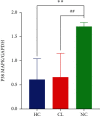Investigating Celastrol's Anti-DCM Targets and Mechanisms via Network Pharmacology and Experimental Validation
- PMID: 35845929
- PMCID: PMC9278495
- DOI: 10.1155/2022/7382130
Investigating Celastrol's Anti-DCM Targets and Mechanisms via Network Pharmacology and Experimental Validation
Retraction in
-
Retracted: Investigating Celastrol's anti-DCM Targets and Mechanisms via Network Pharmacology and Experimental Validation.Biomed Res Int. 2023 Dec 29;2023:9874346. doi: 10.1155/2023/9874346. eCollection 2023. Biomed Res Int. 2023. PMID: 38188814 Free PMC article.
Abstract
Methods: Data from TCMSP and GEO databases were utilized to identify targets for Celastrol on DCM. The relationship between the major targets and conventional glycolipid metabolism was obtained with Spearman correlation analysis. Experiments on animals were conducted utilizing healthy control (HC), low-dose Celastrol interventions (CL), and no intervention groups (NC), all of which had 8 SD rats in each group. To study alterations in signaling molecules, RT-PCR was performed.
Results: There were 76 common targets and 5 major targets for Celastrol-DCM. Celastrol have been found to regulate AGE-RAGE, TNF, MAPK, TOLL-like receptors, insulin resistance, and other signaling pathways, and they are closely linked to adipocytokines, fatty acid metabolism, glycolipid biosynthesis, and glycosylphosphati-dylinositol biosynthesis on DCM. These five major targets have been found to regulate these pathways. Experiments on rats indicated that P38 MAPK was considerably elevated in the cardiac tissue from rats in the CL and NC groups compared to the HC group, and the difference was statistically significant (P < 0.01). Significant differences were seen between the CL and NC groups in P38 MAPK levels, with a statistical significance level of less than 0.05.
Conclusion: Celastrol may play a role in reversing energy remodeling, anti-inflammation, and oxidative stress via modulating p38 protein expression in the MAPK pathway, which have been shown in the treatment of DCM.
Copyright © 2022 Rui Xi et al.
Conflict of interest statement
Authors confirm that there is no conflicts of interest.
Figures








Similar articles
-
Peptide deformylase inhibitor actinonin reduces celastrol's HSP70 induction while synergizing proliferation inhibition in tumor cells.BMC Cancer. 2014 Mar 4;14:146. doi: 10.1186/1471-2407-14-146. BMC Cancer. 2014. PMID: 24589236 Free PMC article.
-
Celastrol Attenuates Cadmium-Induced Neuronal Apoptosis via Inhibiting Ca2+ -CaMKII-Dependent Akt/mTOR Pathway.J Cell Physiol. 2017 Aug;232(8):2145-2157. doi: 10.1002/jcp.25703. Epub 2017 Feb 28. J Cell Physiol. 2017. PMID: 27891586 Free PMC article.
-
Celastrol attenuates renal injury in diabetic rats via MAPK/NF-κB pathway.Phytother Res. 2019 Apr;33(4):1191-1198. doi: 10.1002/ptr.6314. Epub 2019 Feb 15. Phytother Res. 2019. PMID: 30768745
-
Celastrol in metabolic diseases: Progress and application prospects.Pharmacol Res. 2021 May;167:105572. doi: 10.1016/j.phrs.2021.105572. Epub 2021 Mar 20. Pharmacol Res. 2021. PMID: 33753246 Review.
-
Molecular targets of celastrol in cancer: Recent trends and advancements.Crit Rev Oncol Hematol. 2018 Aug;128:70-81. doi: 10.1016/j.critrevonc.2018.05.019. Epub 2018 Jun 5. Crit Rev Oncol Hematol. 2018. PMID: 29958633 Review.
Cited by
-
Retracted: Investigating Celastrol's anti-DCM Targets and Mechanisms via Network Pharmacology and Experimental Validation.Biomed Res Int. 2023 Dec 29;2023:9874346. doi: 10.1155/2023/9874346. eCollection 2023. Biomed Res Int. 2023. PMID: 38188814 Free PMC article.
-
Combining bioinformatics, network pharmacology and artificial intelligence to predict the mechanism of celastrol in the treatment of type 2 diabetes.Front Endocrinol (Lausanne). 2022 Oct 19;13:1030278. doi: 10.3389/fendo.2022.1030278. eCollection 2022. Front Endocrinol (Lausanne). 2022. PMID: 36339449 Free PMC article.
References
-
- Freemantle N., Danchin N., Calvi-Gries F., Vincent M., Home P. D. Relationship of glycaemic control and hypoglycaemic episodes to 4-year cardiovascular outcomes in people with type 2 diabetes starting insulin. Diabetes, Obesity & Metabolism . 2016;18(2):152–158. doi: 10.1111/dom.12598. - DOI - PMC - PubMed
Publication types
MeSH terms
Substances
LinkOut - more resources
Full Text Sources

